Mastering Oven-Baked Brisket: Techniques and Tips
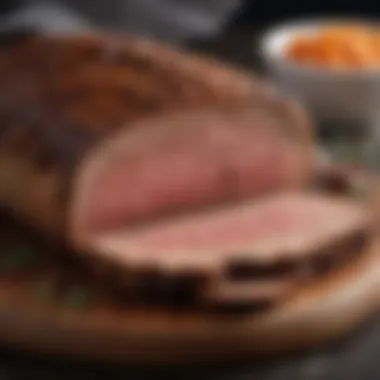
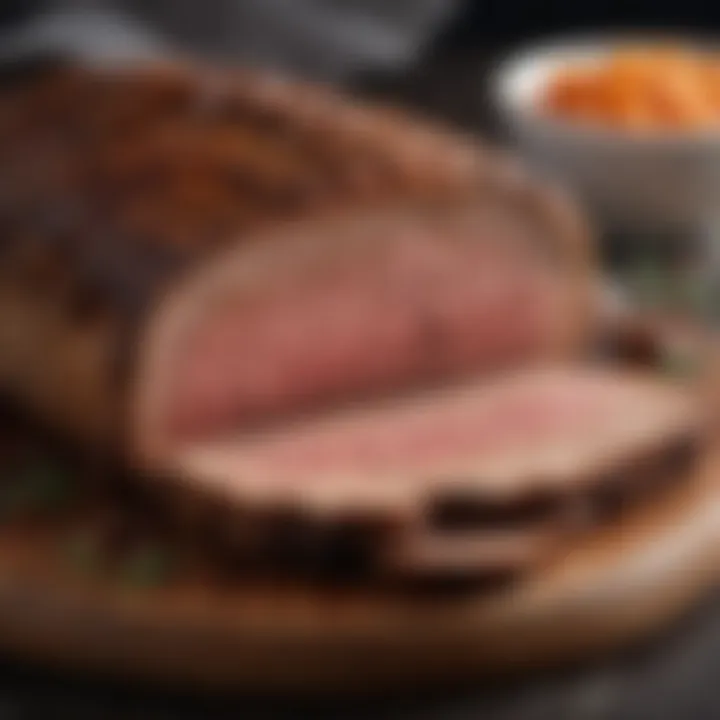
Intro
Baking brisket in the oven is an art that combines patience, technique, and a dash of culinary intuition. This guide will take you through not just the steps involved in the process but also the choices you can make to elevate your dish. Perhaps, you’ve had a friend’s brisket that knocked your socks off, or maybe you’ve only enjoyed this delight in a restaurant. Now, it’s your turn to bring that deliciousness into your home kitchen. Brisket can be intimidating at first glance, but once you unwrap the mystery it holds, you're likely to find it becomes a go-to dish for family gatherings and cozy dinners.
One thing to keep in mind is that the joy of cooking brisket lies in the details; from selecting quality ingredients to mastering cooking techniques, every choice can significantly impact the final output. This article is designed to navigate you through the various components, keeping both novice cooks and seasoned chefs in mind.
Oven-baked brisket not only boasts rich, deep flavors but also offers a versatile canvas for your culinary creativity. With the right know-how, you will understand how to achieve that melt-in-your-mouth tenderness and distinctive flavor profile that can make even the most modest of celebrations feel special.
So, buckle up as we dive into the delectable world of oven-baked brisket and uncover the secrets to mastering this beloved staple.
Preface to Brisket
When it comes to hearty meals that warm the soul, few dishes command as much respect as brisket. This cut of meat, rich in flavor and versatility, plays a starring role in many an occasion, from family gatherings to festive celebrations. Understanding brisket is not simply about knowing how to cook it; it’s about appreciating its history, quality, and distinct cooking techniques. In this article, we’ll delve into every aspect of oven baking brisket, ensuring that both novice and experienced cooks walk away with valuable insights.
Understanding Brisket Cuts
Brisket, at its core, is derived from the chest area of a cow. However, not all brisket cuts are created equal. There are mainly two sections in a brisket: the flat and the point. The flat is leaner and provides slices that are clean and neat, while the point has more marbling, making it rich and juicy.
- Flat Cut: This cut is often the go-to for recipes where you want to make tidy slices. It's also easier to find in supermarkets.
- Point Cut: If you're seeking flavor and tenderness, the point cut should be your pick. It works wonders in burnt ends.
In understanding different cuts, one must also be aware of the meat's grain. Slicing against the grain is crucial for achieving that melt-in-your-mouth feeling. The fibers of the meat can be as varied as they are numerous, and slicing in the wrong direction could leave you with unpleasant, chewy bites.
History and Cultural Significance of Brisket
Brisket’s appeal extends well beyond taste; its roots delve deeper into cultural significance. Traditionally, this cut has become synonymous with Jewish holiday meals, especially during Passover. When seasoned and slow-cooked, it often finds its way onto tables as a celebratory dish, representing a blend of heritage and culinary artistry.
In Texas, brisket transformed into the cornerstone of barbecue culture, earning renowned status through smokehouses and competitions. It tells a tale of communal gatherings, where friends and family bond over the warmth of the grill and the savory aroma wafting through the air.
As brisket migrates across different cultures, it adapts and evolves. Think about how many styles there are, from the savory Korean BBQ brisket to the smoky Texan version—each tells its own story while grounding itself in technique and tradition. Its history is a testament to resilience and adaptability, embodying a culinary journey that spans continents.
"Brisket cuts across cultural lines, uniting people over a shared love for hearty meals. Its global evolution is a reflection of culinary innovation intertwined with tradition." - Anonymous
Understanding these elements is crucial for appreciating brisket in all its glory. With this knowledge, we’re better equipped to explore the intricate methods required to bake it perfectly in the oven.
Choosing the Right Brisket
Choosing the right brisket can be the difference between a mediocre meal and a knock-your-socks-off feast. There’s a whole world of brisket out there, so understanding what makes a good cut, and how different grades affect the final product is crucial.
Selecting Quality Meat
When it comes to selecting quality brisket, it's essential to focus on a few key aspects. First, look for a well-marbled piece of meat. This marbling, or the intramuscular fat, plays a pivotal role in keeping the brisket moist and flavorful during the lengthy cooking process. You want that fat to break down slowly, creating that tender, melt-in-your-mouth texture. If the brisket looks leaner than a gym enthusiast in January, you might want to think twice.
Another aspect to consider is the color. A deep red hue typically indicates freshness. If the meat leans toward a grayish tone, it's a sign that it might be past its prime. A trip to a local butcher can also do wonders. Not only can they guide you toward quality cuts, but they might also have insider tips about local farms or specific breeds that elevate the brisket to another level.
Understanding Grades of Brisket
Brisket is graded primarily based on the quality of the meat and its fat content. The United States Department of Agriculture has several grades, but the main ones you’ll encounter are Prime, Choice, and Select.
- Prime: This is the crème de la crème of brisket. It's abundantly marbled and makes for an especially tender and flavorful bite. If you're planning a special occasion, this is your go-to choice.
- Choice: Generally considered a solid choice for tender and tasty brisket without breaking the bank, Choice brisket has slightly less marbling than Prime. That said, it still delivers a satisfying experience.
- Select: This grade is a leaner option. While you can still make a decent brisket with Select, you might need to intervene more, such as marinating or basting, to keep it juicy. Be ready for a bit of a struggle if you choose this route.
Choosing the right brisket isn't just about grabbing the first one you see. It's about looking for quality, understanding different grades, and making sure you're set up for success before even turning the oven on.
Preparing the Brisket
Preparing the brisket is a vital step in the overall process of cooking this hearty cut of meat. It can be the difference between a mouth-watering feast and a disappointing meal. Before you even turn on the oven, the way you approach trimming and seasoning the brisket sets the stage for the flavors and textures to come. Let’s break it down to ensure that you’re well-equipped to deliver a perfect brisket.
Trimming the Brisket
Trimming is often overlooked, but it’s crucial not just for aesthetics but also for cooking performance. Brisket comes from the breast area of a cow, which means it’s a tough cut filled with fat and connective tissues. Removing excess fat is essential for the final product to be tender and enjoyable.
When it comes to trimming, there are two main types of fat to consider: the hard fat and the silverskin. The hard fat is the thicker layer on the outside of the brisket; while some fat is necessary for flavor and moisture, too much can lead to a greasy finish. Silverskin, on the other hand, is a thin, silver membrane that is tough and chewy. Removing this is wise, as it won’t break down during cooking.
Here’s how to trim your brisket properly:
- Start with a sharp knife. This makes the process easier and helps you control your cuts.
- Trim the hard fat down to about a quarter-inch thick.
- Remove any silverskin you see. Just slide your knife under it and pull it away gently.
Taking the time to trim your brisket not only enhances its appearance but allows the flavors of your rub or marinade to penetrate better into the meat.

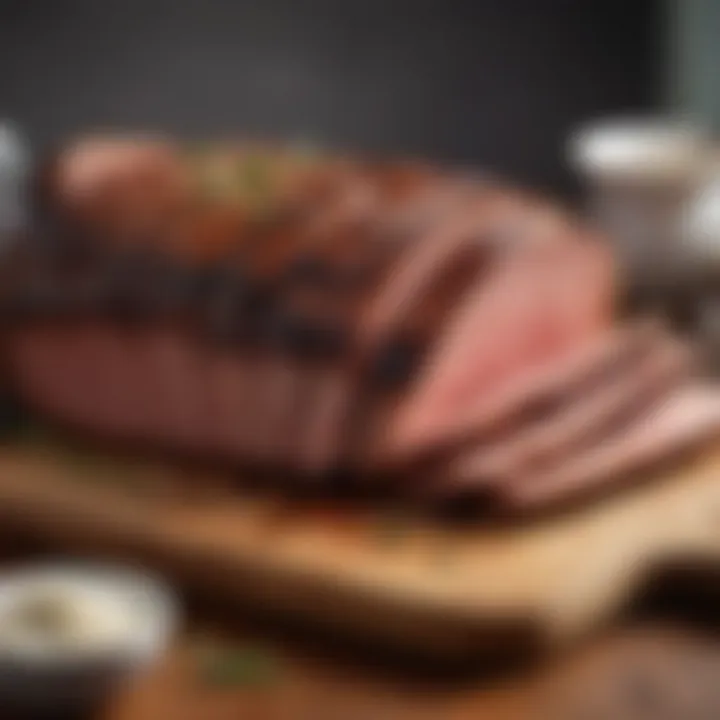
Marinating vs. Dry Rubs
Now, let’s dive into the flavoring aspect of brisket, which can be divided into two main schools of thought: marinating and dry rubs. Each method has its own merits and can produce fantastic results, depending on what flavor profile you want to achieve.
Marinating involves soaking the brisket in a mixture of liquids and seasoning—usually comprised of acids, spices, and sometimes sugars. The idea is to infuse moisture and flavor deep into the meat. A typical marinade might include ingredients like soy sauce, vinegar, garlic, and herbs. The downside? You’ll need time; a good marinade often requires at least a few hours or even overnight.
On the flip side, there’s the dry rub. Dry rubs consist of a blend of spices and herbs that you massage directly into the brisket. They create a flavorful crust when cooked, thanks to the Maillard reaction. Plus, they allow for quicker prep time than marinating. A basic dry rub might include salt, pepper, paprika, and garlic powder. The beauty of dry rubs is their versatility; you can mix and match spices according to your palate.
In the end, whether you choose to marinate or dry rub, the decision should be based on your preferred flavor profile and the time you have on hand.
"The perfect brisket is not just about the meat; it's in the preparation that the magic begins."
In summary, preparing the brisket should never be viewed as a mere checkpoint. Instead, it serves as a foundation for a successful cooking experience. With careful trimming and the right seasoning approach, you’re setting yourself up for a delicious outcome.
The Science of Brisket Cooking
Understanding the science behind cooking brisket is crucial for anyone looking to elevate their culinary skills in the kitchen. Brisket is a unique cut of meat, notorious for its coarse fibers and distinct flavor that sets it apart from other cuts. This section aims to demystify the processes at play when this tough yet delicious meat is transformed into a tender, flavorful dish through the magic of the oven. The method you choose for cooking brisket can greatly affect not only the texture but also the flavor, making it essential to grasp these scientific principles.
Understanding Meat Fibers
At its core, brisket contains long strands of muscle fibers that run parallel to one another. These fibers are intertwined with connective tissue, which contributes to its toughness. When cooking brisket, particularly in an oven, our goal is to break down these fibers while also allowing moisture to penetrate the meat. The muscle fibers are primarily made up of proteins, and as they are subjected to heat, they undergo a transformation.
- The key components include:
- Collagen: This protein, found in connective tissue, begins to melt and gel at higher temperatures, leading to that fall-apart tenderness many brisket lovers crave.
- Myoglobin: The pigment responsible for the deep red color of meat, myoglobin changes to various shades of brown when subjected to heat, indicating its cooked state.
When brisket is cooked properly, the heat causes the collagen to break down, which helps transform it into gelatin. It's this gelatin that contributes to the rich mouthfeel and succulence of the final dish. Understanding this process highlights why cooking brisket slowly and at low temperatures can yield far superior results compared to fast, high-heat cooking methods.
The Role of Low and Slow Cooking
The term "low and slow" is more than just a catchy phrase; it’s a philosophy grounded in culinary science. When you bake brisket at low temperatures—typically around 225°F to 275°F—over an extended period, the meat has ample time to undergo essential changes. Here are some key benefits of this approach:
- Enhanced Flavor: As brisket cooks slowly, it allows for deeper flavor development. The natural fats and juices in the brisket mingle and infuse the meat with a rich, savory essence.
- Tender Texture: The prolonged cooking time allows for a gradual breakdown of tough fibers, making the meat extraordinarily tender. You’ll find that the fibers become less chewy, resulting in a more enjoyable eating experience.
- Moisture Retention: One might think that quick cooking would retain moisture better, but that’s a misconception. Low and slow cooking ensures the moisture within the meat is preserved, helping to avoid that dryness that can occur with rapid cooking methods.
"Patience is a virtue, especially in the kitchen. Slow-cooked brisket is the delicious reward for your willingness to wait."
In the context of oven baking, this method translates to placing your brisket in a preheated oven and allowing it to do its magic uninterrupted. Covering the brisket with foil or butcher paper can also aid in moisture retention, forming a mini steam chamber that ensures your meat cooks evenly from all sides.
By mastering these scientific principles, you can unlock the true potential of brisket in your kitchen. Understanding meat fibers and embracing the low and slow technique equips you with the tools needed to produce mouthwatering results each and every time.
Oven Baking Techniques
Oven baking techniques represent the backbone of successfully preparing brisket in an oven setting. Choosing how to approach the cooking process significantly impacts the outcome of the brisket. With many nuances involved, mastering the oven baking technique can be a game changer, providing the means to achieve that melt-in-your-mouth tenderness and rich flavor profile that many strive for.
When it comes to oven baking, temperature control is critical. Not only does it determine how well the outside of the brisket is seared, but it also affects how evenly the heat penetrates the meat. Getting the temp just right can mean the difference between a brisket that is tough and chewy and one that breaks apart with minimal effort. Additionally, the right oven settings help to maintain moisture, drawing out the inherent flavors of the beef without drying it out.
Moreover, utilizing wrapping techniques can also enhance the cooking process. Wrapping the brisket during various stages can hold in moisture and heat, allowing for a more uniform cook and juicier results. There’s a balance to strike, though; too tight of a wrapping might lead to steamed meat instead of that perfect bark everyone loves. Finding these golden rules will aid in avoiding frequent missteps.
With that context established, let’s delve into the specifics of:
Selecting the Right Oven Temperature
Determining the optimal oven temperature for baking brisket is akin to tuning a musical instrument; too sharp or too flat will throw off the entire arrangement. In general, a temperature between 225°F to 275°F is preferred for slow-cooked brisket. Low heat fosters the breakdown of tough connective tissues while retaining moisture.
Using a lower temperature is important for tough cuts like brisket; this allows the collagen to gradually break down. Most home cooks find that a lower heat yields a brisket that is noticeably more tender. Finding that sweet spot may involve some trial and error. However, keep it in mind that fluctuations in temperature, even minor, can impact cooking times and texture.
When setting your oven temperature, consider your outcome. A brisket cooked at a higher temperature will cook faster, but that speed comes at the expense of tenderness. It’s important to take the time needed for the meat to really benefit from the heat.
It’s not just about heat; it’s about how you use it.
Methods of Wrapping Brisket
Wrapping brisket serves a purpose that goes beyond just aesthetics. There are several methods one might employ, and each brings out unique characteristics in the finished product. Two popular wrapping techniques are the use of butcher paper and aluminum foil.
- Butcher Paper: Often favored amongst BBQ enthusiasts, butcher paper allows the brisket to breathe slightly while still trapping moisture. This means you can achieve that coveted bark while keeping the inside succulent.
- Aluminum Foil: If your primary aim is to maintain moisture, then wrapping in aluminum foil may be your best bet. Foil seals the meat tightly, causing it to steam, ensuring that it emerges juicy but with a softer crust.
Each method has its pros and cons, so the choice really hinges on what you’re ultimately after. Try experimenting with different methods during cooking phases. For example, starting with no wrap and then wrapping halfway through can allow the brisket to develop a beautiful crust while preserving moisture for the second half of the cooking process.
In summary, the oven baking techniques hold great significance in the journey to create a perfectly cooked brisket. Understanding the right temperature to set, paired with effective wrapping methods, forms the foundation for juicy, tender results that will surely impress anyone at the dining table.
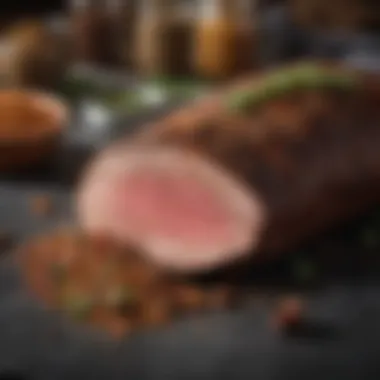
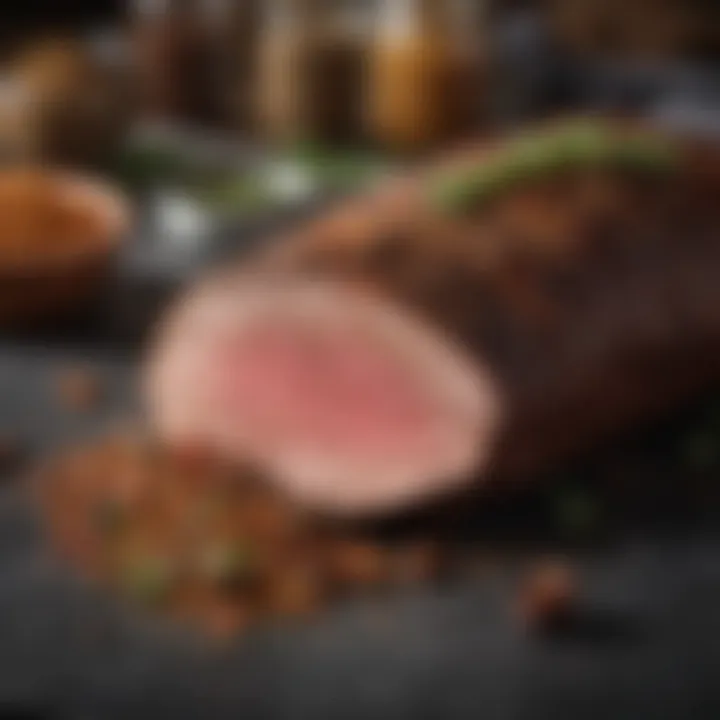
Essential Cooking Tools
Having the right tools when diving into the world of brisket baking is like having a sturdy ship before sailing the stormy seas. These tools can set the stage for your culinary adventure, ensuring that each step you take is both easier and more effective. In this section, we will discuss key utensils and equipment that will elevate your brisket game.
Investing in Quality Cookware
When it comes to baking brisket, quality cookware is paramount. You want materials that not only endure high temperatures, but also provide even heat distribution. Enter the enameled cast iron Dutch oven, a versatile piece that chefs swear by. Not only does it hold heat beautifully, but its sturdy lid traps moisture, keeping your brisket tender and juicy throughout the cooking process.
Using a roasting pan that has a fitted rack can also come in handy. This allows you to lift the brisket out safely without wrestling with tongs. Opt for pans that are both durable and large enough to accommodate your brisket without cramping it too much; you’ll thank yourself later.
Remember:** A little extra investment in quality cookware can save you from culinary heartache. You wouldn’t want a poorly made pan warping in the oven, ruining your efforts just when you’ve got things cooking right!**
Meat Thermometers and Their Importance
Now, let’s move on to meat thermometers. They serve as your culinary compass, guiding you through the often murky waters of doneness. An instant-read thermometer is a must-have in your kitchen arsenal, especially when the stakes are high with a beautifully marbled brisket on the line.
Using a thermometer does two things: it takes the guesswork out of cooking and helps prevent the dreaded overcooking — which can turn a potential masterpiece into a dry disappointment faster than you can say ‘low and slow’.
- Why You Should Use a Meat Thermometer:
- Precision: Ensures your brisket is cooked to perfection, giving you confidence in the final result.
- Doneness Levels: Different cuts of brisket might require different internal temperatures, and having a thermometer helps to guarantee you hit those marks.
- Peace of Mind: Especially for those new to baking brisket, knowing the temperature ranges eases anxiety about the cooking process.
"A meat thermometer can prevent a meal from becoming a miss."
In summary, investing in quality cookware and a reliable meat thermometer forms the backbone of your brisket baking toolkit. Good tools help you focus on what truly matters: creating a delectable, sumptuous dish that you and your diners will enjoy.
Timing and Monitoring
When it comes to oven baking brisket, getting the timing right is not just important; it’s crucial. The quality of the final dish hinges on the careful monitoring of time throughout the cooking process. Timing affects everything—from the tenderness of the meat to its overall flavor profile. In essence, it defines success in the battle of cooking this robust cut of beef.
The first consideration is how long to cook the brisket. This can vary based on several factors such as the size of the cut, the oven temperature, and the method applied. For those in the know, it’s not uncommon for brisket to require anywhere from brisket 1.5 to 2 hours per pound at a low temperature. Keeping an eye on the clock prevents both overcooking and the dreaded undercooking, which can leave the meat tough and unappetizing.
Another element integral to successful brisket cooking is maintaining constant oven temperatures. Uneven heat can wreak havoc with cooking times, leading to parts of the brisket being overdone while others remain raw. Hence, it's not just about setting a timer; understanding your oven’s quirks and ensuring consistent heat is imperative to avoid culinary disaster.
"Cooking brisket isn’t about strict adherence to time; it’s about learning to read the meat."
In terms of functionality, a good cooking process starts with awareness of carryover cooking. This refers to the phenomenon where meat continues to cook even after being taken out of the oven due to retained heat. Knowing when to pull the brisket is as important as knowing how long it needs to bake.
Calculating Cooking Time
When calculating cooking time, it’s important to factor in a few dynamics. As a rule of thumb, aim for 1.5 to 2 hours per pound, but don’t just take that at face value.
- Cut Thickness: Thicker cuts will take longer—don’t rush it.
- Desired Doneness: Everyone has their own preferences for doneness. Do you want more fat rendered or a smokier flavor? Adjust your time accordingly.
- Oven Calibration: If your oven is prone to hot spots or fluctuates in temperature, you might need to extend your cooking time. An oven thermometer might be a small investment but could save your dinner plans.
- Estimation Techniques: Many experienced cooks suggest using a simple formula: 1 hour at 300°F + 1 hour for each additional pound over 3 pounds. It’s not foolproof, but it gives a rough estimate.
Checking for Doneness
Checking for doneness is an art and a science, especially with such a dense piece of meat as brisket. There are various methods to ensure you’ve reached the ideal state of tenderness:
- Internal Temperature: The most common method is using a meat thermometer. A brisket is generally done when its internal temperature hits about 195°F to 205°F. At this stage, the collagen breaks down, and the meat should be meltingly tender.
- Visual Cues: Look for a reliable bark developing on the outside; this not only adds flavor but signals that the meat is cooking properly. The color should be a deep mahogany.
- The Fork Test: If you don’t have a meat thermometer handy, you can use a fork to test for tenderness. Simply insert it into the brisket and twist. If you can easily twist it, the meat is likely done.
- Resistance Check: The brisket should offer some resistance when probed but not be hard. It’s a balance that comes with experience.
Combining these methods will give you a keen sense of whether your brisket is finished cooking or requires more time. Remember, patience is your best friend in the kitchen.
Resting the Brisket
Resting the brisket is a critical step that often gets overshadowed by other aspects of cooking. Many cooks, especially novices, may be eager to slice into their creation as soon as it comes out of the oven. However, this can lead to a less-than-ideal eating experience. Let’s dig into why resting is so important and how to do it effectively.
The Importance of Resting
When you cook brisket, the muscle fibers contract and lose moisture. If you immediately slice into the brisket once it’s done, much of that moisture will escape, leading to dry meat. Resting gives the juices a chance to redistribute throughout the meat. According to various culinary studies, allowing the brisket to rest for at least 30 minutes significantly improves its juiciness and tenderness.
The benefits of resting extend beyond just moisture retention. It also aids in the overall flavor development as the meat settles. This resting period allows the flavors to meld together, making for a richer, deeper taste. It’s akin to letting a fine wine breathe; both need time to reveal their full potential.
Additionally, resting allows the internal temperature to stabilize. During cooking, the outer layers of the brisket heat up more quickly, while the inside remains a bit cooler. By resting the meat, you give the center a chance to warm up, ensuring a more consistent texture and flavor in each bite.
"Patience may be a virtue when waiting, especially when it comes to cooking."
Proper Techniques for Slicing
Once your brisket has had its time to rest—preferably wrapped in foil or a clean kitchen towel to keep it warm—it’s time to slice. How you slice your brisket matters immensely.
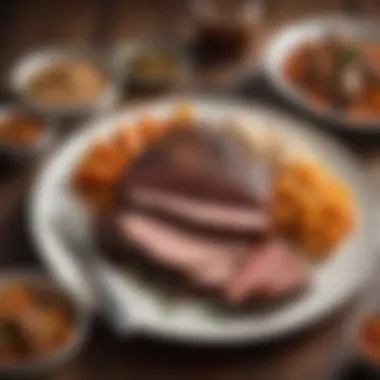
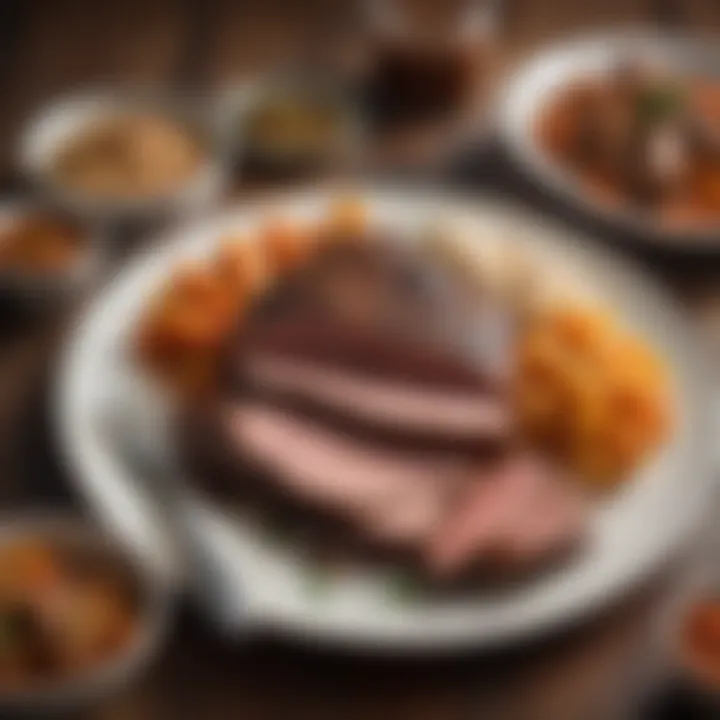
- Let It Cool Slightly: After resting for 30 to 60 minutes, the brisket should be cool enough to handle but warm enough to remain juicy.
- Use a Sharp Knife: A sharp knife will help make clean cuts and minimize the risk of tearing the meat. A dull knife can crush the fibers rather than slice them.
- Slice Against the Grain: Pay attention to the direction of the muscle fibers. Slicing against the grain will yield more tender pieces. If you cut with the grain, you may end up with chewy portions that are less enjoyable to eat.
- Thickness Matters: Aim for around a half-inch thickness for each slice. This ensures that each piece is substantial enough to hold up to sauces or sides, yet thin enough to be tender.
- Keep the Brisket Moist: As you slice, it can be beneficial to drizzle a bit of the pan juices or a light sauce over the meat. This adds flavor and moisture back to the slices, enhancing the overall eating experience.
By implementing these techniques, you can elevate your brisket servings to a new level, making your guests feel like they're dining at a top-notch barbecue joint.
Serving Suggestions
Serving suggestions are often the unsung heroes of a meal, but they play a pivotal role in enhancing the overall dining experience. When you’ve taken the time and effort to prepare a delicious oven-baked brisket, the way you serve it can take it to another level. A well-thought-out presentation and complementary dishes not only showcase your culinary skills but also elevate the meal’s flavor profile, making the experience memorable.
A succulent brisket can sometimes steal the show, but the right side dishes and condiments can make it shine even brighter. When it comes to pairing, it’s about balancing flavors, textures, and colors. Keep in mind any dietary restrictions of the guests, and don’t shy away from experimenting with regional specialties.
Side Dishes that Complement Brisket
Finding the perfect side dish for brisket is like picking the right partner for a dance. You want them to complement each other seamlessly, without one outshining the other.
- Coleslaw: A classic choice, coleslaw offers a crunchy texture and a refreshing tang that offsets the richness of brisket. You can mix it up with various styles, from traditional recipes to something with a kick, like spicy jalapeño slaw.
- Roasted Vegetables: Seasonal veggies, like carrots, Brussels sprouts, or root vegetables, add warmth and earthiness. Roasting brings out their natural sweetness, creating a delightful contrast to the savory meat.
- Cornbread: This Southern staple adds a touch of sweetness and a crumbly texture that pairs wonderfully with brisket. You can enhance it by adding jalapeños or cheese for an extra layer of flavor.
- Pickles: Whether it’s dill pickles or a sweeter variety, pickles bring crunch and a punch of acidity that cuts through the flavor of the brisket, refreshing the palate with every bite.
- Baked Beans: The smokiness of baked beans can perfectly echo the flavors of brisket. You may include pieces of brisket in the bean dish itself for a delicious, integrated experience.
- Mashed Potatoes: Creamy mashed potatoes act as a perfect base. You can elevate them with garlic, cheese, or herbs for a more complex flavor.
While these side dishes are wonderful options, don't hesitate to get creative or customize according to your taste.
Pairing with Sauces and Condiments
Now let’s talk about what you can drizzle or slather on your brisket to take it from good to great. The right sauces and condiments can add depth and character to the flavor.
- Barbecue Sauce: A staple in brisket preparation, barbecue sauce can range from tangy to sweet. Try a vinegar-based sauce for a zesty kick or a dark, molasses-infused sauce for a richly sweet coating.
- Chimichurri: This Argentine sauce made from parsley, garlic, vinegar, and oil brings a bright and garlicky contrast that cuts through the richness of the meat.
- Horseradish Cream: For those who enjoy a bit of heat, horseradish cream can add a delightful spiciness that pairs superbly with the smoky notes of brisket.
- Mustard: A simple yet effective condiment, mustard can add acidity and kick, enhancing the rich flavors of the meat.
- Hot Sauce: Keep it on the table for those who enjoy a bit of fire with their meal. The heat from a good hot sauce can highlight subtle flavors in the brisket, making each bite more exciting.
Experimenting with sauces can lead to delightful discoveries. You might just find your new favorite combination!
Common Mistakes to Avoid
Baking brisket can seem as simple as setting it in the oven and walking away, but it’s anything but that. While the process might feel straightforward, many home cooks make blunders that can drastically affect the final outcome. Understanding the common pitfalls not only helps to refine your cooking technique, but it also enhances the flavor and texture of the meat, leading to that mouthwatering experience everyone craves.
It's definitely worth a few moments to grasp what to steer clear of; after all, nobody wants to end up with a dry piece of meat or a chewy mess that could double as shoe leather. Below, let’s dig into two of the most frequent missteps to watch out for while navigating the oven baking process.
Overcooking or Undercooking
When it comes to brisket, achieving the right doneness is crucial. Overcooking often results in dry, tough meat that practically begs for moisture, while undercooking can leave the meat chewy and unpalatable. Both scenarios can leave you feeling frustrated after all that work.
- Why It Matters: Cooking brisket to just the right level of doneness not only impacts the texture but also the flavor. The goal is to let the connective tissues break down, which can only happen with appropriate heat and time. Too much heat or not enough will throw that balance off.
- Internal Temperature to Aim For: Generally, you want to aim for an internal temperature of around 195°F to 205°F for brisket. This range ensures that you achieve the tender, juicy texture you seek.
- Checking the Temperature: Use a reliable meat thermometer. Don’t rely on guesswork and just assume if it looks done. Insert the thermometer into the thickest part of the meat for the most accurate reading.
A brief
anecdote: A friend of mine swore by the time method; he set a timer and focused solely on that. One day I had him check the temp, and he was shocked to find out he far overshot the mark. The brisket pretty much got the boot—no second chances at that point!
Neglecting to Account for Carryover Cooking
Once you pull the brisket from the oven, the cooking doesn’t stop there. This is critical to understand. Carryover cooking occurs when residual heat in the meat continues to cook it even after you’ve taken it out of the oven. Ignoring this fact can lead to disappointment as your meat continues to climb in temperature, often surpassing the ideal doneness.
- How Much Does it Cook?: On average, brisket can rise about 5°F to 10°F after it’s removed. So, if you've targeted that perfect 205°F mark, taking it out at around 200°F can save you from ending up with an overcooked bite.
- Let It Rest: The other piece of this puzzle is to allow the brisket to rest for a proper amount of time. This not only helps in redistributing the juices throughout, providing a succulent bite but also allows some of that carryover cooking to take place.
- Paying Attention to Timing: For resting, you’re looking at anywhere from 30 minutes to an hour at room temperature, covered with foil. Avoid cutting into it right away, even if the aroma lures you in. Having patience yields juicier slices.
Understanding these common mistakes will not only help you navigate the quirks of oven baking brisket but also arm you with the knowledge needed to truly master this dish.
By avoiding overcooking, undercooking, and neglecting carryover cooking, you'll be well on your way to serving up a feast that your family and friends will rave about.
End
As we wrap up this exploration of oven baking brisket, it’s crucial to remember that this culinary journey goes beyond just cooking meat. The art of preparing brisket gives you insight into various cooking techniques, the importance of proper meat selection, and the secrets of flavor enhancement. Each step discussed in this article plays a vital role in producing a brisket that’s not just edible but is a point of pride for any cook.
Throughout the sections, we emphasized how the combination of low cooking temperatures, the right seasoning, and that oh-so-important resting period influences the final product. Neglecting any of these components could mean the difference between a mouthwatering feast and a dry, tough outcome. Thus, mastering the nuances of brisket preparation is essential for both novice and experienced cooks alike.
Recapitulating the Key Points
- Understanding Brisket Cuts: Different types of briskets offer various textures and flavors, so knowing what to choose—is key.
- Preparation Techniques: From trimming the fat to marinating or applying dry rubs, these steps set the stage for extraordinary flavor.
- Cooking Science: Grasping meat fibers and the reasons behind slow cooking will allow you to deliver tenderness unlike any other means.
- Temperature & Timing: Choosing the right oven temperature and timing cooking is like the difference between driving in a race or being stuck in traffic.
- The Importance of Rest: Never skip this step! Letting the brisket rest helps juices redistribute, leading to a succulent bite.
- Serving Suggestions: Complement your brisket with fitting side dishes and sauces to elevate the overall dining experience.
- Common Pitfalls: Steering clear of mistakes like overcooking or neglecting carryover cooking can save you from a culinary disaster.
Ultimately, keeping these points in mind helps in delivering a mouthwatering brisket each and every time.
Encouragement to Experiment and Personalize
Each cook has their own style, and brisket is the perfect platform to let your creativity shine. There’s no one-size-fits-all approach, so why not play with flavors that resonate with your taste buds? Perhaps you prefer a sweet cherry wood smoke or a bold coffee rub. Experimenting with ingredients allows you to make the dish truly your own.
In the realm of cooking, practice makes perfect. So, don’t hesitate to try different oven temperatures or adjust cooking times until you find what works best with your kitchen setup.
"The greatest meals are the ones we put our own twist on and share with those we love."
Engage with flavors from different cuisines, whether it might be adding a hint of Asian influence with ginger and soy or merging traditional BBQ flavors with spices from the Mediterranean.
In summary, this adventure into brisket cooking can be as vast as your imagination allows it to be. So gather your tools, choose your brisket, and step into the kitchen with the confidence that you’ll create something remarkable every time.







